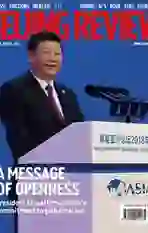Lost in Protectionism
2018-05-06ByMeiXinyu
By Mei Xinyu

On March 22, U.S. President Donald Trump signed a memorandum targeting Chinas so-called “economic aggression,” threatening to impose tariffs on up to $60 billion of imports from China based on an investigation into alleged Chinese intellectual property and technology transfer practices under Section 301 of the U.S. Trade Act of 1974. He also directed the U.S. Treasury Department to propose restrictions on Chinese investment in the United States.
While warning that the Chinese side will fi ght to the end in any trade war, China on April 2 launched a countermeasure in response to a previous U.S. move to impose tariffs on steel and aluminum imports. The Ministry of Finance announced the suspension of tariff concessions on 128 items of U.S. products.
Subsequently, on April 4, the Office of U.S. Trade Representative (USTR) published a proposed list of approximately 1,300 Chinese goods worth $50 billion subject to additional 25-percent tariffs. China responded on the same day with additional tariffs of 25 percent on 106 items of U.S. products under 14 categories of the same value. The following day, Trump said he had asked the USTR to consider imposing tariffs on $100 billion of imports from China. In response, China said it has prepared detailed countermeasures.
A possible trade war between the worlds two largest economies has led to fl uctuations in global fi nancial markets. It will definitely be the most influential event in international trade in 2018 if the war occurs.
With decades of development, todays China is strong enough to impose at least the same level of damage to the United States—which is provoking a trade war—and it is willing to use this strength if necessary. However, a trade war is never good for any side. Moreover, it is a daydream to imagine the reconstruction of a domestic real economy by relying on protectionism rather than reform. To avoid this no-win prospect, the best thing the United States can do is to withdraw from its protectionist measures.
Unfounded accusations
The allegations against China in the Section 301 investigation launched by the Trump administration in August 2017 are untenable. When China drafted its regulations on technology transfer, it took the Draft International Code of Conduct on the Transfer of Technology in 1985 as a reference point. The United States participated in the drafting of this UN code, thus, China is conforming to international practices.
Moreover, intellectual property rights(IPR) are not supreme, with internationally recognized standards in place to prevent their abuse. In the Agreement on TradeRelated Aspects of Intellectual Property Rights of the World Trade Organization (WTO), many articles authorize member states to adopt necessary measures to protect their public interests and prevent IPR holders from abusing their rights.
Particularly it encourages technology transfer to developing countries and allows possible compulsory measures if necessary. For instance, Article 8 states:
1. Members may, in formulating or amending their laws and regulations, adopt measures necessary to protect public health and nutrition, and to promote the public interest in sectors of vital importance to their socio-economic and technological development, provided that such measures are consistent with the provisions of this Agreement.
2. Appropriate measures, provided that they are consistent with the provisions of this Agreement, may be needed to prevent the abuse of intellectual property rights by right holders or the resort to practices which unreasonably restrain trade or adversely affect the international transfer of technology.
Regarding technical cooperation, Article 67 states:
In order to facilitate the implementation of this Agreement, developed country Members shall provide, on request and on mutually agreed terms and conditions, technical and fi nancial cooperation in favor of developing and least-developed country Members. Such cooperation shall include assistance in the preparation of laws and regulations on the protection and enforcement of intellectual property rights as well as on the prevention of their abuse, and shall include support regarding the establishment or reinforcement of domestic offices and agencies relevant to these matters, including the training of personnel.
So, whether the U.S. unilateral Section 301 investigation has been launched to prevent the abuse of IPR, inappropriate trade restrictions and unfavorable influence on international technology transfer or not, it is not diffi cult to draw a conclusion.
Trumps intentions
To accurately predict the results of the possible trade war and its ultimate social and economic impact, we have to make a calm and objective analysis of the concerns of Trump.
Trumps philosophy can be summed up as “mercantilism being better than protectionism.” Raising the flag of “America first,”he is paying unprecedented attention to the reconstruction of the U.S. real economy compared to his predecessors over the past few decades. As a result, in his fi rst National Security Strategy report, he listed economic security as one of the four pillars of national security.
Trump is the f irst U.S. president to clearly state that “national security means economic security.” His “blue water” foreign policy emphasizes unilateralism and an almost total disregard of the Atlantic world and the institutional web that developed among the Cold War allies. As Walter Russell Mead, a fellow at the Hudson Institute and the James Clarke Chace Professor of Foreign Affairs and Humanities at Bard College, said in The Wall Street Journal, “Blue-water strategists in the Trump national security team believe that it is American power, not multilateral institutions, that keeps the West afloat. If challenges to American power from countries like China, Russia, Iran and North Korea are successful, the wider West will weaken and crumble.”
Trump is not only continuing and escalating the path of indifference toward the WTO initiated by Barack Obama, but he is also demanding that it be significantly revised. Meanwhile, he has already withdrawn the United States from some existing regional free trade agreements. Trump appears to prefer bilateral trade agreements and has a penchant for provoking trade disputes.
However headstrong Trump may seem to be, he must stand the test of economic rules. Many of his ideas are destined to fail. For example, launching trade wars to force trading partners acceptance of market access conditions favorable to the U.S. side is one such idea bound for failure. The proposed trade war against China is based on this pipe dream.
Trump hopes to convince manufacturing jobs to return to the United States and narrow the countrys trade deficits. However, if he doesnt thoroughly reform the welfare and trade union systems in the United States, he will never realize this goal. Continued economic prosperity and a salary increase after tax reform will help stimulate U.S. imports while expanding the countrys current account deficits. Moreover, Chinas national strength is big enough, and even though Trumps tough style may force most other countries to yield, it will not work with China.
In the first year of Trumps presidency, some of his schemes that ran counter to economic rules didnt have enough time to be rebuffed in practice, but now in his second year, such ideas will run into a brick wall. The trade war he wants to start against China may be the fi rst such rebuff.
Negative effects
After the subprime crisis in 2008, U.S. economic recovery has continued for nearly eight years. By the end of the fi rst quarter of this year, the country had seen its second longest economic growth spell in modern times. Its economic growth is also accelerating. Throughout 2017, the U.S. economy grew 2.3 percent year on year, and in the fourth quarter, it rose 2.5 percent. However, in good fortune lurks bad luck.
The economic cycle is inevitable and decline will definitely come. Particularly, on the U.S. stock market which has remained bullish throughout this round of recovery, there have been countless bubbles. When will these bubbles burst? How will these problems affect Trumps governing capabilities, reelection prospects and new measures to address trade wars?
The U.S. stock market appears to be particularly fragile against the impact of a trade war between China and the United States. On April 2 and 4, the U.S. stock market, global stock markets and even commodity markets all took a dive, especially after the USTR published its proposed tariff list on Chinese products on April 4. If Trump is to really put the list into effect and levy punitive tariffs, it will inevitably intensify the infl ation pressure on the United States, forcing the U.S. Federal Reserve to raise its benchmark interest rates, which in turn will lead to a crash landing of the U.S. stock market.
One of the significant reasons Trump wants to launch a trade war against China is to garner greater support in the midterm elections taking place in November. But because of his ill-founded motives and many weak areas of the United States in a possible trade war against China, Trump may not benefi t from his actions. In fact, Chinas retaliation may prove to undermine Trumps base of support. Most of the automobiles and farm produce on Chinas list of 25-percent retaliatory tariffs are produced in the states that heavily supported Trump in the 2016 general election.
Beyond all question, as the largest goods exporter in the world, China will be immediately affected by the anti-globalization trend and a trade war. However, in a larger context, as an emerging major country, China will benefit most in the long run from healthy competition with the United States—an established power—because moderate external competition pressure will encourage self-improvement and self-renovation.
